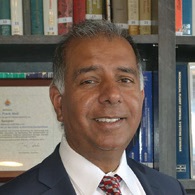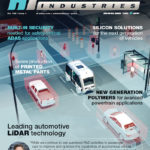Additive manufacturing is going mainstream faster thanks to advances such as a simulation suite which utilizes detailed material modelling and multi-scale progressive failure analysis to augment AM process simulation, drive build optimization and support virtual in-service qualification of an as-built printed part.
More significantly, the software can accurately predict deformation, warpage, residual stress, damage initiation, damage propagation, porosity, and other manufacturing anomalies commonly attributed to 3D printing, according to the developers of the GENOA 3DPm additive manufacturing (AM) design tool and software suite for polymers, metals and ceramics, AlphaSTAR.
Automotive Industries (AI) asked Dr. Rashid Miraj, Director of Technical Operations, AlphaSTAR Corporation, how he thinks AM will revolutionize automotive manufacturing.
Miraj: AM already has the ability to produce complex, lightweight parts with bionic designs that meet or exceed existing performance requirements. However, AM struggles with part qualification and finish. Once this challenge is addressed, AM can move on to the fabrication of structural elements and critical parts, which will trigger a rapid broad-based adoption of the technology through multiple industries.
As more companies learn how to apply AM to their business model, adoption will transition from a linear growth model to an exponential one. It should be noted that a by-product of the AM revolution is the explosion of start-up automotive firms. For decades the capital cost of a new manufacturing plant has been prohibitive. The affordability of AM Metal and AM polymer means a greater number of entrepreneurs can explore the development of niche vehicles or specialist aftermarket parts. In the very near future, AM innovations established by these start-ups will trickle into the workflow of major automotive OEMs.
AI: How is AlphaSTAR working on cutting down material waste?
Miraj: AM process simulation provides a manufacturer with an opportunity to virtually watch a build and identify manufacturing anomalies as they occur. GENOA 3DP provides the additional capability of understanding the relationship between anomalies and print parameter settings in the form of parameter sensitivities. With the application of optimization routines, GENOA 3DP can utilize this information to identify the ideal print parameters settings to reduce or eliminate anomalies and ensure parts are correctly built the first time and every time.
AI: How does your upgraded GENOA3DP v9 suite address efficiency and cost?
Miraj: In a recent application with a major defense contractor, GENOA 3DP accurately predicted build issues related to net shape and residual stress. Next, with the aid of design of experiment modelling optimization, the tool was able to identify the source of the problems and identify print parameter settings, build orientation and supports to eliminate the concerns. The finished articles were delivered and qualified for service. Here, GENOA 3DP eliminated the need for trial and error printing, eliminated the corresponding material waste and drove down to the optimized solution over a few steps rather than through repeated builds. The utilization of GENOA 3DP saved the OEM time, money and, most significantly, utilized and established value in an expensive in-house AM printer that had previously been considered a lost investment due to lack of productivity and ability to yield quality parts.
AI: What are some of the advantages of PathCoverage and TMg modules?
Miraj: PathCoverage can act as a standalone tool to identify macro voids and anomalies related to the print path and print parameter settings. Consider a tool path and tool speed that turns sharp corners into smooth curves. In this scenario, net shape would be a concern. PathCoverage can identify these concerns and, when integrated with GENOA3DP, can predict the consequences in terms of anomalies and structural deficiencies related to the final build.
TMg calculates through-the-thickness thermal history and the dynamic evolution of the melt pool, which includes width, depth, and length; as well as thermal states, such as heating, melting, superheating, solidification, and cooling. Designers can use TMg to predict transient changes of thermal conductivity and material states (i.e. voids, density, and volume of solid) within a build. TMg can generate process maps, which identify regions of stability and instability with respect to different AM print settings. These regions include stable, no-melting, partial-melting, over-heating, balling, humping, unfused powder, and keyholing.
TMg can be used in processes such as laser powder bed fusion (LPBF), selective laser sintering (SLS), fused deposition modeling (FDM), big area additive manufacturing (BAAM), and air plasma sprayed thermal barrier coating (APS TBC). Additionally, TMg can be used to model multi-material systems which combine metals, polymers and ceramics.
AI: What makes you confident that AM is the future of manufacturing?
Miraj: Lightweight design and safety are important automotive engineering structural issues. AM metal and AM polymer technologies are positioned to address both concerns. AM provides designers with the ability to consider shapes and geometry that cannot be built with traditional subtractive methods. Further, AM can be coupled with topological optimization and generative design to yield parts that are optimized in relation to multiple criteria such as weight and cost.
GENOA 3DP has the ability to simulate the AM process, virtually optimize the AM build, and, uniquely, subject the virtual as-built part and or vehicle to service loads. Thus, in its drive for quality and meeting performance requirements, GENOA 3DP can evaluate a design for safety, reliability, and manufacturability. Further, the software technology can undertake parametric studies to consider numerous design variations without committing resources such as materials, hardware or personnel. When combined with AM’s capacity to rapidly prototype a part and move from imagination to innovation, GENOA 3DP and AM are excellent fits for the automotive industry.
AI: Why do you think AM can transform the automotive landscape?
Miraj: First it will disrupt the way vehicles and vehicle parts are made. AM has the potential to transform the fabrication and distribution of spare parts into an on-demand service, which ultimately frees warehouse space and creates a new type of parts provider that store raw materials rather than spare parts.
Continuing with spare parts, legacy sustainment parts would simply be captured in an electronic file that could be shared freely as a public resource or made available through paid download. AM will be equally impactful with regard to vehicle manufacturing. The assembly of vehicles is a time-honored tradition, but the manufacture of vehicles has always been a big money game. Yet, because of the lower cost threshold associated with AM manufacturing, the technology has introduced new manufacturers into the mix who have fresh ideas, boundless enthusiasm and a real love for vehicles and vehicle design.
AM has the potential to place innovation back in the hands of the consumer, who would have the opportunity to act on his or her inspiration rather than wait for something selected by an OEM executive. In summary, AM will democratize the automotive industry, which can only lead to better products and higher quality.
AI: How closely does AlphaSTAR work with OEMs?
Miraj: AlphaSTAR has working relations with several automotive OEMs. Having served the aerospace community for the past 30 years, we know a thing or two about advanced composite materials, continuous fibers, chopped fibers, laminas, laminates, weaves, light weighting, fatigue, durability/damage tolerance, injection molding and compression molding. Our knowledge of chopped fibers and crush analysis has been of interest to European and Asian manufacturers. Thus, our primary contribution has been in the application of structural composites and advanced material systems to light-weighting of electric and hybrid platforms. In the future our knowledge polymer AM will also apply to that technology.














































 Built-in security needed for safety-critical ADAS applications
Built-in security needed for safety-critical ADAS applications Intelligent dash-cams ready for series OEM installation
Intelligent dash-cams ready for series OEM installation Sustainable and high-performance polymers for automotive applications
Sustainable and high-performance polymers for automotive applications Circular Economy is “Hottest Ticket” for the Global Plastics and Rubber Industries
Circular Economy is “Hottest Ticket” for the Global Plastics and Rubber Industries LeddarTech Exhibits LiDAR Technology at CES 2020 from January 7-10 in Las Vegas, USA
LeddarTech Exhibits LiDAR Technology at CES 2020 from January 7-10 in Las Vegas, USA With record-breaking figures Automechanika Shanghai celebrates more than just its 15th edition miles
With record-breaking figures Automechanika Shanghai celebrates more than just its 15th edition miles


